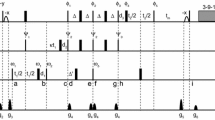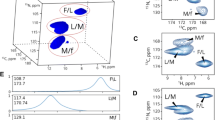Abstract
NMR spectroscopy is a powerful method in structural and functional analysis of macromolecules and has become particularly prevalent in studies of protein structure, function and dynamics. Unique to NMR spectroscopy is the relatively low constraints on sample preparation and the high level of control of sample conditions. Proteins can be studied in a wide range of buffer conditions, e.g. different pHs and variable temperatures, allowing studies of proteins under conditions that are closer to their native environment compared to other structural methods such as X-ray crystallography and electron microscopy. The key disadvantage of NMR is the relatively low sensitivity of the method, requiring either concentrated samples or very lengthy data-acquisition times. Thus, proteins that are unstable or can only be studied in dilute solutions are often considered practically unfeasible for NMR studies. Here, we describe a general method, where non-uniform sampling (NUS) allows for signal averaging to be monitored in an iterative manner, enabling efficient use of spectrometer time, ultimately leading to savings in costs associated with instrument and isotope-labelled protein use. The method requires preparation of multiple aliquots of the protein sample that are flash-frozen and thawed just before acquisition of a short NMR experiments carried out while the protein is stable (12 h in the presented case). Non-uniform sampling enables sufficient resolution to be acquired for each short experiment. Identical NMR datasets are acquired and sensitivity is monitored after each co-added spectrum is reconstructed. The procedure is repeated until sufficient signal-to-noise is obtained. We discuss how maximum entropy reconstruction is used to process the data, and propose a variation on the previously described method of automated parameter selection. We conclude that combining NUS with iterative co-addition is a general approach, and particularly powerful when applied to unstable proteins.




Similar content being viewed by others
References
Barna J, Laue E, Mayger M, Skilling J, Worrall S (1987) Exponential sampling, an alternative method for sampling in two-dimensional NMR experiments J Magn Reson (1969) 73:69–77
Daniell GJ, Hore PJ (1989) Maximum entropy and NMR—A new approach J Magn Reson (1969) 84:515–536
Fiaux J, Bertelsen EB, Horwich AL, Wuthrich K (2002) NMR analysis of a 900 K GroEL GroES complex. Nature 418:207–211
Havel T, Wüthrich K (1984) A distance geometry program for determining the structures of small proteins and other macromolecules from nuclear magnetic resonance measurements of intramolecular 1 H-1H proximities in solution. Bull Math Biol 46:673–698
Hodgkinson P, Holmes KJ, Hore PJ (1996) Selective data acquisition in NMR. The quantification of anti-phase scalar couplings. J Magn Reson Ser A 120:18–30
Holland DJ, Bostock MJ, Gladden LF, Nietlispach D (2011) Fast multidimensional NMR spectroscopy using compressed sensing. Angew Chem Int Ed 50:6548–6551
Hyberts SG, Takeuchi K, Wagner G (2010) Poisson-gap sampling and forward maximum entropy reconstruction for enhancing the resolution and sensitivity of protein NMR data. J Am Chem Soc 132:2145–2147
Ikura M, Kay LE, Bax A (1990) A novel approach for sequential assignment of proton, carbon-13, and nitrogen-15 spectra of larger proteins: heteronuclear triple-resonance three-dimensional NMR spectroscopy. Application to calmodulin. BioChemistry 29:4659–4667
Jaravine VA, Orekhov VY (2006) Targeted acquisition for real-time NMR spectroscopy. J Am Chem Soc 128:13421–13426
Kazimierczuk K, Orekhov VY (2011) Accelerated NMR spectroscopy by using compressed sensing. Angew Chem Int Ed 50:5556–5559
Kazimierczuk K, Zawadzka A, Kozminski W (2008) Optimization of random time domain sampling in multidimensional NMR. J Magn Reson 192:123–130
Lin Z, Lu J, Zhou W, Shen Y (2012) Structural insights into TIR domain specificity of the bridging adaptor Mal in TLR4 signaling. PLoS ONE 7:e34202
Lustig M, Donoho D, Pauly JM (2007) Sparse MRI: the application of compressed sensing for rapid MR imaging. Magn Reson Med 58:1182–1195
Mobli M (2015) Reducing seed dependent variability of non-uniformly sampled multidimensional NMR data. J Magn Reson 256:60–69
Mobli M, Hoch JC (2014) Nonuniform sampling and non-fourier signal processing methods in multidimensional NMR. Prog Nucl Magn Reson Spectrosc 83:21–41
Mobli M, Stern AS, Hoch JC (2006) Spectral reconstruction methods in fast NMR: Reduced dimensionality, random sampling and maximum entropy. J Magn Reson 182:96–105
Mobli M, Maciejewski MW, Gryk MR, Hoch JC (2007) An automated tool for maximum entropy reconstruction of biomolecular NMR spectra. Nat Methods 4:467–468
Mobli M, Stern AS, Bermel W, King GF, Hoch JC (2010) A non-uniformly sampled 4D HCC(CO)NH-TOCSY experiment processed using maximum entropy for rapid protein sidechain assignment. J Magn Reson 204:160–164
Paramasivam S et al (2012) Enhanced sensitivity by nonuniform sampling enables multidimensional MAS NMR spectroscopy of protein assemblies. J Phys Chem B 116:7416–7427
Rovnyak D, Frueh DP, Sastry M, Sun Z-YJ, Stern AS, Hoch JC, Wagner G (2004) Accelerated acquisition of high resolution triple-resonance spectra using non-uniform sampling and maximum entropy reconstruction. J Magn Reson 170:15–21
Rovnyak D, Sarcone M, Jiang Z (2011) Sensitivity enhancement for maximally resolved two-dimensional NMR by nonuniform sampling. Magn Reson Chem 49:483–491
Schuyler AD, Maciejewski MW, Arthanari H, Hoch JC (2011) Knowledge-based nonuniform sampling in multidimensional NMR. J Biomol NMR 50:247–262
Snyder GA et al (2014) Crystal structures of the Toll/Interleukin-1 receptor (TIR) domains from the Brucella protein TcpB and host adaptor TIRAP reveal mechanisms of molecular mimicry. J Biol Chem 289:669–679
Stern AS, Hoch JC (2002) Rowland NMR Toolkit
Stern AS, Donoho DL, Hoch JC (2007) NMR data processing using iterative thresholding and minimum l1-norm reconstruction. J Magn Reson 188:295–300
Thomas V, Nicholas JG, Ashley M, Bostjan K, Stuart K (2012) Adaptors in Toll-Like Receptor Signaling and their Potential as Therapeutic Targets. Curr Drug Targets 13:1360–1374
Valkov E et al (2011) Crystal structure of Toll-like receptor adaptor MAL/TIRAP reveals the molecular basis for signal transduction and disease protection. Proc Natl Acad Sci USA 108:14879–14884
Woo JR, Kim S, Shoelson SE, Park S (2012) X-ray crystallographic structure of TIR-domain from the human TIR-domain containing adaptor protein/MyD88-adaptor-Like protein (TIRAP/MAL). Bull Korean Chem Soc 33:3091–3094
Worley B (2016) Subrandom methods for multidimensional nonuniform sampling. J Magn Reson 269:128–137
Acknowledgements
The authors would like to thank Dimitri Maziuk for assistance in analysis of the BMRB. This work was supported by the Australian Research Council through Discovery Grant DP140101098 to MM and a Future Fellowship to MM (FTl10100925), and the National Health and Medical Research Council through a project grant to MM and BK (APP1081409). BK is an NHMRC Principal Research Fellow (APP1003325 and APP1110971).
Author information
Authors and Affiliations
Corresponding author
Rights and permissions
About this article
Cite this article
Miljenović, T., Jia, X., Lavrencic, P. et al. A non-uniform sampling approach enables studies of dilute and unstable proteins. J Biomol NMR 68, 119–127 (2017). https://doi.org/10.1007/s10858-017-0091-z
Received:
Accepted:
Published:
Issue Date:
DOI: https://doi.org/10.1007/s10858-017-0091-z




